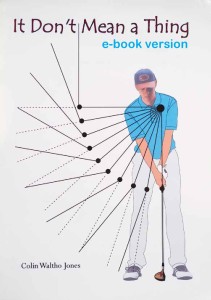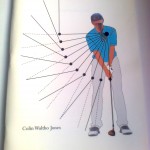Date: March 6th 2011
Format: Medal
Venue: [Home course]
Score: 80
Handicap mark: 4.0
Themes in reply: Reaction to bad shots. Influence of competition formats.
Hi Colin,
I had a gross 80 (net 76) on Sat morning. I played ok but because of the recent frost all the pins were at the front of the greens which makes it a lot harder. Also, there was an easterly wind which again makes the course more difficult as the course is generally set up for the prevailing south westerly.
Anyway, enough excuses. I’m obviously still learning the your routine and although it worked on a good number of shots I also hit a few bad ones which was probably down to poor concentration. Some of the good ones were really good and my playing partner (who plays off scratch) commented how well I was striking the ball and how good the sound of the strike was.
One of the problems is that when the timing is good the ball goes a lot further. E.g. on the 6th I had approx 145 yards to the pin straight into the wind so I selected a 7 iron which I normally hit about 155 yards. I timed the shot spot on and the ball covered the pin but it actually pitched 10 yards past the pin (155 yards approx) and ran to the back of the green giving me a 20 yard putt! I would have expected to hit it about 140 into that wind. My yardages will need to be adjusted.
My score should have been better (as always!) but my tee shot on the par 3 14th leaked into the deepest bunker on the course. Although the top sand was ok the base was still frozen so I took 3 to get out and then compounded the error by 3 putting for a 7 – 4 shots dropped on one hole! But that’s P, all the holes are a challenge and it will always jump up and bite you somewhere.
I’m happy that my golf is progressing but I also know that it will take a bit of time and effort to fully get into the routine.
Many thanks,
John
Dear John,
Fantastic feedback – thank you. You write really well. Thinking about it, writing to me about your golf will have some beneficial effect because it will make you carefully consider aspects of your performance.
How did your score compare with the rest of the field, particularly those that played in the same conditions?
Comment – The only reflection needed for bad shots is: “what was the next one like?” If the next shot was a good one then you must have succeeded in simply moving to the ball after the bad shot and going through the routine and finding the rhythm, which makes the 3 out of a bunker and then the 3-putt a more interesting sequence to consider. Before doing that I want to dispel a myth: the course did not jump up and bite you – you simply hit a sequence of shots that didn’t have the desired outcome. Don’t blame things like fate, history or reputation for your bad shots – only you are swinging the club! Also, don’t blame the conditions: you may not have known about the frozen sand but at worst it only cost you a shot.
Psychologically, it is much more beneficial to take full responsibility for your bad shots at the time, because you need to get cross with yourself in order to wake up your imagination and by extension your subconscious so that your visualisation routine gets more vivid.
I don’t know the hole yet but you shouldn’t have been anywhere near that bunker. The aim is to have control of the ball off the tee so that the next shot is the easiest it can be. Think back to the tee shot and see if there is anything that you did or didn’t do that made the dribble into the bunker more likely than it should have been. Consider your club selection, the conditions, what happened on the tee (interruptions, waits, gusts, banter etc). Most importantly, try to remember your visualisation: did you factor in the importance of avoiding the deepest bunker on the course? Was there a “safer” spot to aim for given the pin position, wind etc? From your description it sounds as if you weren’t quite switched on when thinking about the tee shot, but I might be wrong.
Once in the bunker, the trick is to turn the misfortune to your advantage. As I have said in a previous lesson, the real icing on the cake of this method is that its success, shot by shot, depends on the vividness of your imagination which, in turn, is more vivid the more danger you are in (imagine you are about to be eaten by a sabre-toothed tiger on the Serengeti and you’ve only got one spear left!).
The problem on this occasion is the medal format because the only danger is to your score. It would have been much easier for you to switch your imagination on to full power if you had had an opponent to batter psychologically with a wonderful recovery. So, in medal rounds you need to be extra aware of the need to switch yourself on when you are in trouble.
As you approach the bunker you tell yourself that it is a wonderful opportunity to really test the sweetness of your swing. The visualisation should be super-sharp. The focus on the light sweetness of the swing should be intense. It is a good time to take your time so that you can remember to play the shot on the out-breath.
The second attempt to get out of the bunker is a very difficult challenge to your ability to forget a bad shot and move on (most of the difficulty provided by the embarrassment of failure). So difficult, in fact, that it is very important not to be in there in the first place or to get out at the first attempt. Also, you will become aware of time pressure: humans hate keeping other humans waiting.
The influence of the format now changes in a very interesting and subtle way. At this point in matchplay, you could give up the hole as a bad job; this would relax you, you would probably hit a corker because of the work you had already done on the visualisation, this would give your opponent a little something to think about and would make yourself feel better.
In strokeplay, by contrast, the result of the failure to get out of the bunker is that there is now a severe threat to your score. The trick here is to take a moment and reflect on the threat. Let the threat to your score “fire you up”. Think thoughts like “over my dead body”. Rather than be intimidated by the threat, take it on with a beady eye and shoulders set square.
This all takes time and imagination, and is hard to do because it is easy to get blasé about a medal score. But it is excellent practise in simply using your imagination at what it is good at, i.e. switching on your subconscious. Now the trick is to use your fired up imagination to visualise and feel an even sweeter swing than the last one; a swing so light and easy rhythm that the ball cannot resist being caressed out of that nasty bunker.
I’m not going to consider the 3rd attempt because it is likely after this lesson that it will never happen to you again!
The 3-putts sounds to me like a straightforward case of your routine being de-railed by a combination of frustration at not getting out of the bunker, resignation about the impact on your score and a failure to ignore bad shots. The lesson here is to take a deep breath, smile at your misfortune, get cross and let your cross-ness fire up your imagination. You must never, ever give up on a hole in strokeplay. At your level, every shot over par needs to feel like a dagger in your heart. Remember, it is only a game; but being “only a game” allows us to play with our emotions and use them for our benefit. It really is very easy to trick your subconscious into pulling out all the stops for you by pretending to be cross.
I am highly encouraged by the fact that your bad hole was the 14th. Your overall score suggests that you didn’t let the experience affect the rest of your round. Please let me know your score against par on the last 4 holes.
I am very excited at your progress. The remark from your partner is gold dust. Remember, we have barely started!
Colin


